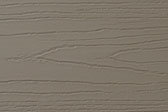
uPVC decking is a plastic alternative to timber and composite decking and cladding materials. It comes in a wide range of styles and colours and requires very little maintenance.

What is uPVC?
Polyvinyl chloride, abbreviated to PVC, is a term that can refer to a number of different materials based on the same vinyl polymer with various other chemical additives. Softer PVC, as used in most plastic kitchen utensils for example, needs to be plasticised, however unplasticised PVC – or uPVC as it’s more commonly known – is far more rigid and is the material used in PVC decking boards and pergola cladding or siding. As such, it is far more durable than plasticised PVC and weathers very well.
The main advantage that uPVC decking and pergola cladding has over wood is that it does not require as much maintenance to keep looking new, just an occasional brush down or wash. It is usually installed without any exposed screws or nails and never needs sanding or sealing. It will keep its colour and feel throughout the decades if it’s looked after.
What are the properties of uPVC?
Earlier versions have been known to be vulnerable to cracking under long term heat and UV exposure, but chemical compounds have been added to more recent blends to overcome this issue. The boards are also incredibly strong and durable, and will never accrue mould or termites. uPVC can also be made very flame retardant, making this a viable choice for decking in some bushfire prone areas.
The trade-off is that uPVC simply isn’t wood. It may have the same look and feel even on a close inspection but many people still view uPVC decking as a cheaper alternative, and there are still many concerns about the harm to the environment caused by uPVC manufacturing. Likewise, if uPVC becomes scratched or otherwise blemished, it’s not as easy to fix as simply resanding or restaining like you might do with timber.
Many people have little time for deck maintenance though, or live in bushfire prone areas where fire resistance is a serious concern, or may find that achieving a certain design or effect is substantially cheaper using uPVC than timber. uPVC can offer a great deal of choice without many of the traditional problems associated with wood.
- Incredibly long lasting, fade and damage resistant.
- Available in a wide range of colours and wood textures to match the look and feel of even aged wood.
- Requires very little maintenance in comparison to wood decking.
What is this material appropriate for?
uPVC decking and pergola cladding makes for a good choice for people who haven’t got the time to maintain a deck, but like to keep their backyard looking good. A wooden deck may need yearly (or twice-yearly) maintenance, but a uPVC deck only needs to be installed and cleaned when dirty.
|
Advantages
|
Disadvantages
|





